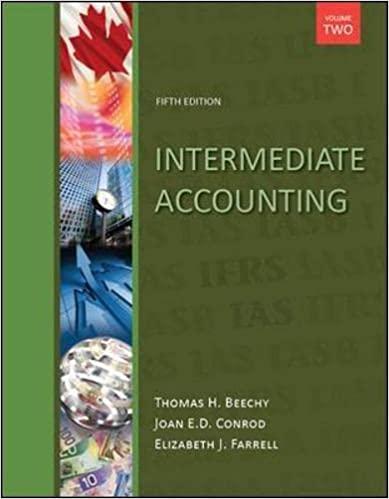ThurTech Limited (TTL) is a Canadian public company involved in network technology for mobility telecommunications. This network
Question:
ThurTech Limited (TTL) is a Canadian public company involved in network technology for mobility telecommunications. This network technology allows additional data services to be offered through a mobile platform, as a strategy to increase average revenue per user for the carriers. TTL's customers are mobility carriers throughout North America and internationally.
Through the first three quarters of \(20 \times 3\), revenues were relatively flat, and profit forecasts, which promised growth of approximately \(12 \%\) in EPS, were not achieved. An earnings growth rate of \(8 \%\) was reported, largely generated through cost reduction. Internal projections indicated that this \(8 \%\) growth in EPS would be reported for the annual results. At the beginning of the fourth quarter, senior management began to discuss ways to "close the gap" between the \(12 \%\) target and the \(8 \%\) actual EPS growth. (Projected annual \(20 \times 3\) EPS figures, reflecting the \(8 \%\) ). Mindful of the sluggish stock market share price, and with an eye on its own compensation and stock option packages, management has expressed interest in changes before the end of the \(20 \times 3\) fiscal year.
TTL has 1.2 million common shares promised for future distribution under option contracts granted to senior management. Stock options are a material element of compensation. Additional options will be granted at the end of \(20 \times 3\). The options granted will be at a price equal to the current share price and will vest immediately. They may be exercised in four years' time, as long as the manager is still with TTL. The quantity to be granted depends on corporate performance but could range from zero to 400,000 shares under option.
A number of situations and/or opportunities that would potentially affect EPS for the year have been discussed internally. For example, management has proposed that 850,000 common shares be repurchased and retired in the fourth quarter. The required funding for this, \(\$ 16,150,000\), would have to be borrowed. Management is permitted to borrow up to \(\$ 2\) billion without further Board of Directors' approval; at the end of the third quarter, outstanding debt amounted to \(\$ 1.8\) billion.
TTL has idle land on the books at an historical cost of \(\$ 695,000\). The market value of this land is \(\$ 1,180,000\); sale would therefore generate a before-tax profit of \(\$ 185,000\). The land is adjacent to one of the five current manufacturing facilities of TTL and has been held for future expansion. Management is confident that, when future expansion is necessary, land can be obtained at one or another of the existing locations for a reasonable sum. Therefore, sale of this idle land has been proposed in the fourth quarter of \(20 \mathrm{X} 3\).
TTL reports one particular bond payable of \(\$ 500\) million on the books, at a fixed interest rate of \(6 \%\). Since market interest rates are now in the range of \(8 \%\), the present value of this debt is \(\$ 470\) million. Management has suggested that this debt be recorded at its present value, recognizing the reduction in debt as a financing gain on the statement of comprehensive income.
TTL has several major orders for product that will be delivered in the first quarter of \(20 X 4\). Management is considering ways to expedite these orders to ensure that delivery is completed in the fourth quarter of 20X3. Management is confident that the company can complete production, although not installation at the customer site. In fact, one customer has indicated that installation will not be possible in 20X3, because of operational and technological issues. However, the customer is willing to accept delivery of the product on the condition that payment not be expected any earlier than if the regular delivery schedule were in force. TTL is willing to accept this condition and indeed will offer it to all customers with orders in \(20 \times 4\) that will accept delivery in \(20 \times 3\). If these orders are booked in \(20 \mathrm{X} 3\), gross profit will increase in the range of \(\$ 800,000\) to \(\$ 1.2\) million.
TTL expects to conclude a transaction with a company located in India, Bombay Telecom Limited (BTL), in the fourth quarter of 20X3. In this transaction, TTL network technology will be exchanged for manufacturing equipment procured by BTL. This equipment will be used to produce a particular component for TTL that will help establish TTL's leading-edge product. Valuation of the transaction is problematic, however. TTL knows that the technology it is shipping to BTL would sell in the range of \(\$ 1.5\) million, but sales of this line are not common and the product was specifically produced for BTL at a cost of \(\$ 600,000\). The equipment acquired does not have a readily established market value, because it is unique. The product line that the equipment supports is projected to have a 10 -year life, producing gross margins of \(60 \%\), but the eventual volume is highly speculative.
Required:
Analyze, for management, the EPS effect of the situations described above. Include a discussion of any concerns for management to consider. TTL has a \(40 \%\) marginal tax rate.
Step by Step Answer:






